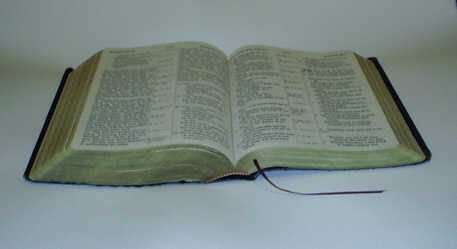
Table of Contents:
This teacher’s copy of the What is the Bible lesson plan is printer-friendly.
RESOURCES:
[1] A book written by one author.
[2] A book containing short stories by different authors.
[3] A Bible (preferably a modern translation, eg: The New International Version (N.I.V.), The Good News Bible, The Living Bible).
[4] A history book, a poetry book, a songbook, and a letter with an envelope.
[5] A picture of the McDonald’s symbol.
STARTER:
Ask for a volunteer to look in the first book [1] to find the author’s name.
Then, a second volunteer finds the authors’ names in the second book. [2]
Lastly, a volunteer to find the Bible’s authors. [3]
(Teacher’s note: Direct the child to the Contents page of the Bible, and to find the Book of Proverbs, then to find the Book of Joel. At the start of both these books it tells you who the author was).
Q. How many books are there in the Bible?
(Teachers note: Direct the children to the Contents page.)
Old Testament 39 books + New Testament 27 books = 66 books total.
Many of these books were written by the same people.
For example, the first 5 books of the Bible were almost certainly written by Moses. (Teachers note: In about two-thirds of the books of the Bible the authorship is definitely known; in one-sixth the author is probably known but it is not a definite fact; and in the last sixth the authors are unknown).
MAIN TEACHING:
As can be seen from the contents page, these 66 books are formed into 2 sections:
The first section is known as the ‘Old Covenant’ (or ‘Old Testament’)
A Covenant is an agreement between 2 people.
Here is an example of a covenant:
Ask for a volunteer. Then write out a ‘Covenant’:
“I ….. (child’s name) do promise to listen to everything that ….. (teachers name) says, and not to be naughty, (etc),” signed ….. (child’s name)
“I ….. (teachers name) do promise to teach ….. (child’s name), (etc),” signed ….. (teachers name)
The ‘Old Covenant’:
The Old Covenant was more serious than this, and it was for a lifetime.
It was between the nation of Israel and God, but that doesn’t mean that it is irrelevant to us now, because:
[a] Through these books it gradually builds up a picture of what God is like.
[b] The ceremonies of the Old Covenant were ‘symbolic’ of the New Covenant which hadn’t come into force at that time.
Through these books gradually builds up a picture of what God is like:
To explain this, ask this question:
Q. How do you describe what God is like when He is invisible?
Tell the class that they’ve got to describe someone from their class to a school in Australia, but they can’t send any photos.
(Teachers note: They can describe what the child looks like, but that doesn’t tell us anything about their character and how this child would react in certain situations, so one good way is for the children to start telling true little stories about this child.)
From the children’s stories about this child, the school in Australia would start to ‘know’ this child.
This is how the Old Covenant (and indeed the whole Bible) deals with explaining about God.
The ceremonies of the Old Covenant were ‘symbolic’ of the New Covenant which hadn’t come into force at that time:
To explain this:
Show the McDonald’s symbol and ask what this is ‘symbolic’ of.
The simple ‘symbol’ represents the whole McDonald’s experience.
A lot of the symbols within the Old Covenant represented different aspects of (different ways of looking at), Jesus Christ, even though these things were written from 400 to 4000 years before Jesus Christ.
The second section is known as the ‘New Covenant’ (or ‘New Testament’).
This covers the life of Jesus Christ and includes the New Covenant between himself and anyone who wants to become a Christian.
The 66 books of the whole Bible are written in different styles and for different reasons:
Show the children the history book, poetry book, songbook, and letter with an envelope [4], and explain the different styles of writing in them.
Q. Would you find these sorts of books and letters within the Bible?
The answer is that you will find all these types of books and even letters within the Bible. There are 8 different styles:
1) HISTORY in the Bible:
This concentrates on the nation of Israel and shows how God interacted with them.
2) The GOSPELS in the Bible
(The word ‘Gospel’ means ‘good news’).
The 4 Gospels are the good news about Jesus Christ, and they cover his life, death and his rising from the dead.
The 4 writers are:
Matthew, Mark, Luke and John, and they all write as ‘witnesses’ in that they saw the things he did.
3) SONGS and POETRY in the Bible:
Both songs and poetry may be to God, or to other people.
It can put into words what we are feeling.
Q. Have you ever heard, or read something which really expresses the way you are feeling?
Q. Has it helped you?
It helps us to know that we are not the only person feeling like this.
4) PRAYERS in the Bible:
Prayers are said to God.
(Teacher’s note: The subject of prayer will be dealt with in another Lesson Plan).
Prayers can be:
- asking God to forgive us for the wrong things that we have done
- or it can be asking God for something,
- or it can be expressing our gratitude to God.
5) LAWS in the Bible:
For example: “You shall not steal.” Exodus 20:15 (NIV)
Q. Do you think that laws like this restrict you, or protect you?
Laws are not there to kill our joy!
They make the world a better place to live in, if everyone obeys the laws.
The Law within the Bible tells us what God expects from us.
6) WISE SAYINGS in the Bible:
For example:
“Pride only breeds quarrels, but wisdom is found in those who take advice.” Proverbs 13:10 (NIV)
Q. Why should pride start quarrels?
Q. Why is it wise to listen to advice (from sensible people)?
Wise sayings give wisdom.
They help us to make the right decisions in our lives.
7) LETTERS in the Bible:
These were written by wise Christians to either individuals or whole Churches.
They contain encouraging things, helpful advice and correction.
(Teacher’s note: Examples of some letters in the Bible are Ephesians, Galatians, and Philippians which are to churches. The letters to individuals are Timothy and Titus.)
8) PROPHECY in the Bible:
This tells people of things before they happen, either to warn people or to prove
a certain point.
For example, many things in Jesus’ life and death were given in prophesies hundreds of years before it happened, to prove that He is the Son of God.
(Teachers note: Christians believe that this is different from trying to predict the future by using palm reading, horoscopes, mediums, etc. The Bible condemns such activities because they can manipulate and trap people.)
Different translations of the Bible:
Most of the Old Testament was written in ‘Hebrew’, which was the language of the Israelites (the Jews).
Most of the New Testament was written in ‘Greek’, which was the most common language in the known world at that time.
Q. So what had to be done so that we could read it?
The whole Bible had to be translated into the English language.
The Bible, as of 2007, has been translated in its entirety into less than 500 of the world’s estimated 6,900 languages. An estimated 2,700 translations are ongoing.
One of the early translations was known as the King James Version and was
completed in 1611.
(Teachers note: The first complete English translation was completed in the late 1300′s).
The King James Version is not very easy to understand, because the English language has evolved since then.
Here is an example of the King James Version:
For verily I say unto you, till heaven and earth pass,
Matthew 5:18 (KJV)
one jot or one tittle shall in no wise pass from the law,
till all be fulfilled.”
Try to work out what it this verse is saying and then write it out in your own words.
Here is a modern translation of the same verse:
I tell you the truth, until heaven and earth disappear,
The New International Version.
not the smallest letter, not the least stroke of a pen,
will by any means disappear from the Law until everything is accomplished.”
Q. What do Christians think of the Bible?
Christians describe the Bible as being God’s Word.
Even though different people wrote the Bible, they believe that it was God who spoke to them, therefore God can ‘speak’ to anyone now who reads it.
PLENARY:
The people in the Bible stories show us that people then, experience the same fears and feelings as we do now.
Q. Do you think someone living 4000 years ago had the same feelings and disappointments as we do?
The Bible contains many stories of ordinary people who do great things because God was with them, and there are stories of people in extremely difficult situations and how God helped them.
(Teachers note: there are two worksheets to accompany this lesson plan):
What is the Bible? Worksheet 1
What is the Bible? Worksheet 2
Also see the: What is the Bible? RE resources
